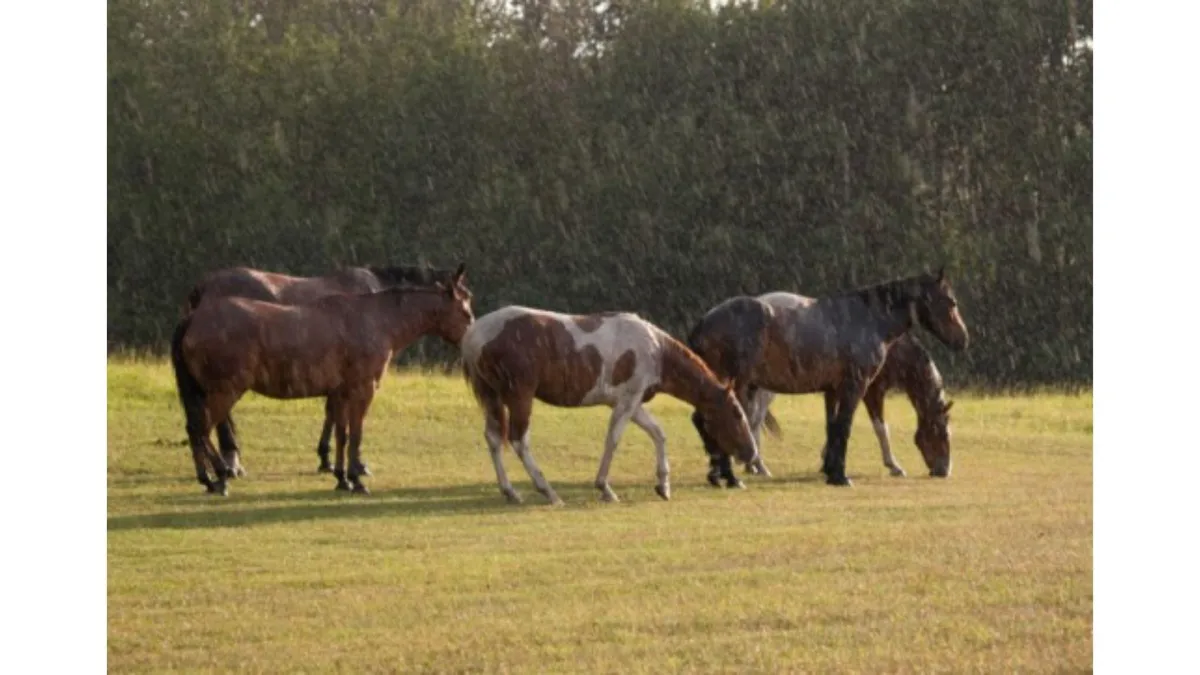
Livestock appreciate shelter from bad weather
Most livestock can tolerate rain, wind or cold on their own. But when two or more of these conditions occur together, animals can quickly become chilled. Once they begin shivering, their feed requirements rise sharply. Without extra nutrition, weight loss follows fast.
Which Livestock Need Shelter Most
The animals most vulnerable to weather stress are:
The young and the old
The newly shorn and fine-skinned
Animals in poor body condition
Animals that are unwell
This applies across species including goats, cattle, sheep, alpacas, deer, horses and ponies.
Goats Need Extra Care
Goats are especially vulnerable to cold, wind and rain. They have little fat under the skin and their coats are not waterproof, which means they chill easily and need access to dry, sheltered areas.
You should avoid tethering goats unless there is no alternative. Goats are social animals that prefer freedom to move and the company of other goats. If tethering is unavoidable, it comes with strict legal requirements under New Zealand animal welfare regulations.
Tethered goats must always have access to shelter that is dry, shaded, and protects them from both hot and cold extremes
They must also have unrestricted access to food and water, and be checked at least every 12 hours
It is illegal to tether kids, pregnant or lactating does, or sick or injured goats
For more detail, see our full article on tethering goats.
Goats are not as hardy as many people believe. Even healthy adult goats benefit from a dry shed or windproof shelter, especially overnight or during prolonged wet weather.
Horses Benefit from Covers and Shelter
Horses need shelter from wind, rain and cold, especially lighter breeds like thoroughbreds. Many appreciate a winter cover.
Use waterproof covers fitted correctly to avoid rubbing
Regularly check under covers for skin condition and body weight
Newborn Animals Are at High Risk
Newborn animals are highly vulnerable to bad weather. Rain, wind and cold combined can be lethal.
Providing shelter for heavily pregnant animals is like taking out an insurance policy. It greatly improves the odds of survival for their young.
Twin and triplet newborns are especially at risk
Pregnant ewes, cows and does need plenty of feed and shelter as their due dates approach
Lamb covers can help but must be well-fitted and not frighten the mother
Monitor lambs wearing covers in case they become tangled
Shorn Sheep Need Feed and Protection
Newly shorn sheep require good pasture for at least six weeks post-shearing. In poor weather, they also need shelter.
Using a cover comb or blade shearing leaves some wool for insulation
Shelter is essential during this recovery period
Prelamb Shearing Can Be Beneficial
Shorn ewes are less likely to become cast and more likely to seek shelter and bring their lambs with them. Shearing also boosts metabolic rate, helping prevent sleepy sickness, and can increase lamb birthweight and survival.
However, only shear pregnant ewes in winter if:
You use a cover comb
You provide up to 50 percent more feed than normal
There is effective shelter before and after lambing
Bare-bellied shorn or crutched ewes may avoid lying down on cold ground, meaning lambs can't shelter beside them. Good shelter is essential to make shearing worthwhile.
Planting Shelter for the Future
Winter is an ideal time to plant trees and shrubs to create long-term shelter and shade.
Consider:
Fast-growing species
Native bush or low flax
Tall conifers or deciduous trees like poplar and willow
Multi-purpose species that provide firewood or stock feed (tree lucerne, ash, poplar)
For effective shelter:
Combine low shrubs for ground-level protection with taller trees to slow wind
Avoid macrocarpa where cattle may browse fallen branches, as this can cause abortion
Fence both sides of the shelter belt to prevent damage
Ensure shelter is continuous along at least two sides of a paddock
Common Problems with Shelter Belts
Many shelter belts are ineffective due to:
Gaps at ground level where stock need protection most
Poor placement on wet ground, leading to muddy lee sides
Overuse of a limited shelter area, which becomes a disease risk
Short belts that do not provide full wind protection
Expert Advice Pays Off
Planting shelter is a long-term investment. It’s worth seeking advice from a local expert to ensure your species selection and layout match your site and needs. Well-planned shelter can improve animal welfare, reduce feed requirements and add value to your property.
Summer Shade is Just as Important
Trees provide critical shade during hot weather.
Shade reduces heat stress and supports animal comfort
It helps prevent sunburn and eases the effects of facial eczema
Evergreen belts for wind shelter work best when aligned north-south
Deciduous trees offer better summer shade when planted east-west
Temporary Shelter Options
Shelter belts take time to grow, but temporary solutions can help protect young or vulnerable animals now.
Use wind netting on fences on the windward side of the paddock
Line up big bales close to fences (outside the paddock) to act as a windbreak
Arrange hay bales inside the paddock in a V-shape facing into the prevailing wind to shelter smaller stock
Want to learn more about animal care and shelter planning
Our What You Need to Know Before You Keep Livestock course helps lifestyle farmers get the basics right.

